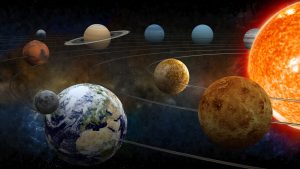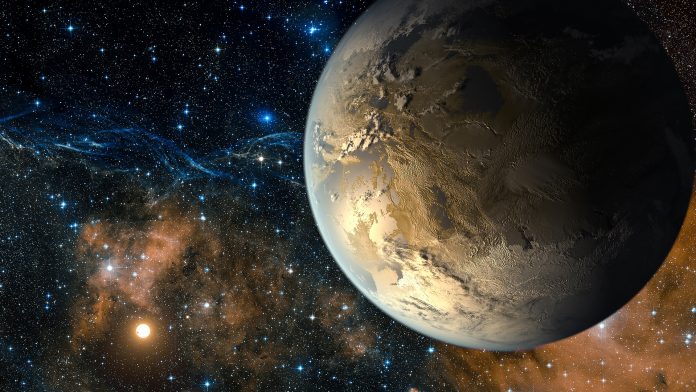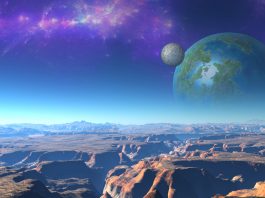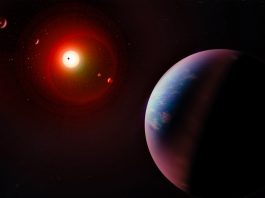Researchers have found that there might be fewer habitable planets than first thought, due to an Earth-like planet orbiting an M dwarf appearing to have no atmosphere.
New research has revealed that an Earth-like planet orbiting an M dwarf, the most common type of star in the Universe, appears to have no atmosphere. This discovery has shown that there could be fewer habitable planets than currently thought, which has the potential to trigger a significant shift in searching for space creatures.
As M dwarfs are all over the Universe, this breakthrough means that a large number of planets that orbit these stars could also lack atmospheres and are thus unlikely to possess life.
The research, titled ‘GJ 1252 b: A Hot Terrestrial Super-Earth with No Atmosphere,’ was published in the Astrophysical Journal Letters.
GJ 1252 b: The planet with no atmosphere
GJ 1252 b differs from Earth in a variety of ways. For example, the planet orbits its star twice during the course of a single day on Earth, it is slightly larger than Earth, and notably, it is much closer to its star than Earth is to the Sun. These factors contribute to GJ 1252 b being both intensely hot and non-habitable.
Michelle Hill, UC Riverside Astrophysicist and study co-author, stated: “The pressure from the star’s radiation is immense, enough to blow a planet’s atmosphere away.”
The Sun also causes Earth to lose some of its atmosphere over time, but carbon cycling processes such as volcanic emissions make the loss barely noticeable by helping replenish what is lost. However, if the planet is closer to a star, it cannot keep replenishing the amount of its atmosphere that is being lost.
This fate is felt by Mercury. The planet does have an atmosphere, but it is extremely thin as it is comprised of atoms blasted off its surface by the Sun. The atoms escape into space due to the planet’s extreme heat.
The astronomers discovered GJ 1252 b’s lack of atmosphere by measuring infrared radiation from the planet as its light was obscured during a secondary eclipse. This eclipse occurs when a planet passes behind a star – blocking the planet’s light and the light reflected from the star.

According to the researchers, the radiation revealed that the daytime temperatures of GJ 1252 b are estimated to reach 2,242°F. At this temperature, gold, silver, and copper would melt. From the planet’s recorded heat and low surface pressure, the researchers concluded that the planet has no atmosphere, which therefore calls into question the likelihood of potentially habitable planets.
GJ 1252 b would be unable to hold on to an atmosphere, even with the presence of a large amount of carbon dioxide, which traps heat.
“The planet could have 700 times more carbon than Earth has, and it still wouldn’t have an atmosphere. It would build up initially, but then taper off and erode away,” said Stephen Kane, UCR Astrophysicist, and study co-author.
The proximity of M dwarf stars reduces the potential of habitable planets
The researchers posed that the likelihood of habitable planets is reduced by the proximity of M dwarf stars. This is because M dwarf stars tend to have more flares and activities than the Sun, showing that there is little chance that the planets surrounding them are able to hold on to their atmospheres.
“It’s possible this planet’s condition could be a bad sign for planets even further away from this type of star,” Hill said. “This is something we’ll learn from the James Webb Space Telescope, which will be looking at planets like these.”
This research was backed by a grant from the Future Investigators in NASA Earth and Space Science and Technology program.
The team was led by Ian Crossfield at the University of Kansas and included scientists from UC Riverside, as well as NASA’s Jet Propulsion Laboratory, Caltech, University of Maryland, Carnegie Institution for Science, Max Planck Institute for Astronomy, McGill University, University of New Mexico, and the University of Montreal.
Most of the 5,000 stars in Earth’s solar neighbourhood are M dwarfs. Even if planets orbiting them can be ruled out entirely, there are plenty of other potentially habitable planets.
“If a planet is far enough away from an M dwarf, it could potentially retain an atmosphere. We cannot conclude yet that all rocky planets around these stars get reduced to Mercury’s fate,” Hill said. “I remain optimistic.”









